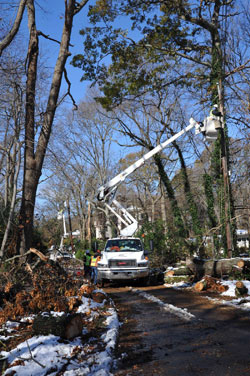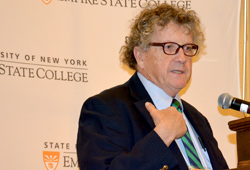January 7, 2014
“Sandy Stories, Organized Labor Rebuilds New York” Returns to SUNY Empire State College
“When the Lights Go Out,” a Multimedia Theatrical Performance Debuts in Saratoga

These members of the International Brotherhood of Electrical Workers were among the thousands of unionists who worked to during and after Hurricane Sandy. (Photo/IBEW Local 2032)
(SARATOGA SPRINGS – Jan. 7, 2014) “Sandy Stories, Organized Labor Rebuilds New York,” an exhibit of photographs taken by working men and women during and after Hurricane Sandy, and “When the Lights Go Out,” a multimedia theatrical performance about those who helped in the rebuilding, will be hosted by SUNY Empire State College at 113 West Ave., Saratoga Springs, NY.
The performance and a reception will take place Thursday, Jan. 16, from 5-8:30 p.m. The art show is now open Monday-Friday during normal business hours, 9 a.m.-5 p.m., and will continue through Jan. 31. The public is welcome to attend both at no charge.
The show and performance were successfully debuted at the college’s Harry Van Arsdale Jr. Center for Labor Studies in December 2013.
Presented by the New York State AFL-CIO and the Workforce Development Institute, the exhibit honors workers and their efforts and sacrifice during and after the hurricane and was conceived by WDI Executive Director Ed Murphy.

Ed Murphy, executive director of the Workforce Development Institute, talks about "Sandy Stories: Organized Labor Rebuilds New York" (2013). This exhibit of photos taken by workers during and after Hurricane Sandy, will be open throughout the conference. (Photo/Empire State College)
Cameras were provided by WDI to a number of unions in order to document the destruction brought on by Sandy and the subsequent rebuilding efforts.
“Superstorm Sandy was one of the worst in American history,” said Murphy. “On October 29, 2012, New York and New Jersey were hit by uncontrollable flooding. Power lines came down, streets, tunnels and subway lines were rapidly flooded, cutting power in and around New York City. Thousands and thousands of public workers, transit workers, electrical workers, teachers, nurses, mechanics and volunteers worked tirelessly to put New York back together for us all. ‘Sandy Stories’ recognizes and applauds their tireless efforts.”
“When New Yorkers were knocked down by Sandy, union members were there to lift them up,” said Mario Cilento, president of the New York State AFL-CIO. “Working men and women from the public sector, private sector and building trades prepared for the impact, responded to emergencies when the storm hit, cleaned up its aftermath and are rebuilding so that we are stronger than ever. They demonstrated the resilience of New York and that there is no challenge we can't overcome when we work together.”
“Lifting others up, sharing what they can and doing what they must is what trade unionists are all about,” said Michael Merrill, dean of the college’s Harry Van Arsdale Jr. Center for Labor Studies. “’Sandy Stories’ tells tales and shows scenes from an extraordinary moment, not unlike those we heard and saw of emergency response and rescue after 9/11. The truth is that trade unionists live these principles every day. We are proud to participate in honoring extraordinary heroes.”
Members of the International Brotherhood of Electrical Workers Local 3 were among the thousands of unionists who worked to rebuild in the aftermath of the storm. Through the Joint Industry Board of the Electrical Industry, IBEW Local 3 pays for its apprentices to earn an associate or bachelor’s at the college’s labor center as part of their apprenticeship.
Local 3 Journeyman Electrician Stephen Flynn, an adjunct member of the faculty at HVACLS, Local 3 apprentices and labor center students Volodymry Sulyk and Danny Ferreyra ’13, as well as labor center adjunct faculty Sean Broesler and Kate Spaulding, shared their firsthand experience with Sandy as part of a panel discussion, “Sandy – Victims and Volunteers,” during the college’s 2013 Student Academic conference.
Middle and high school students from New York City attended the presentation and interviewed the panelists after the discussion as part of developing “When the Lights Go Out,” which is based on the stories of Flynn, Sulyk, Ferreyra, Broesler and Spaulding.
With the guidance of Noelle Gentille, a social justice theater artist and consultant for WDI, who created the concept and directs the piece, and Amelia Whalen who created the play, the students will perform “When the Lights Go Out” as part of the event. The performance is produced by Gentille and Victoria Kereszi, ‘Sandy’ film footage was provided by Josh Rask, videography is by Darian Henry and JD Falitico is the projection artist.
About the Workforce Development Institute
The Workforce Development Institute's mission is to improve the lives of working men and women across New York state by developing regional solutions to workforce, economic and community development challenges.
As a partner to the New York State AFL-CIO and area labor federations, WDI's agenda is shaped by the needs of specific regions, businesses and unions. WDI provides timely support for new and incumbent worker training, acts as a convener to bring together labor, business, government and others to find solutions to workforce and economic development challenges. WDI promotes diversity in the workforce through programs that focus on women and underserved populations.
WDI’s cultural programs are aimed at increasing worker visibility and dignity by giving voice and vision to their hopes, struggles and daily lives. WDI believes that the culture and creativity of working people has been pivotal to the triumphs of labor and other social justice movements throughout history.
About SUNY Empire State College
SUNY Empire State College was established in 1971 to offer adult learners the opportunity to earn associate, bachelor’s and master’s degrees from the State University of New York.
In addition to awarding credit for prior college-level learning, the college pairs each student with a faculty mentor who supports that student throughout his or her college career. Students engage in guided independent study and course work onsite, online or through a combination of both, which provides the flexibility for students to learn at the time, place and pace they choose.
The college serves more than 20,000 students worldwide at more than 35 locations in the state of New York and online. Its 70,000 alumni are active in their communities as entrepreneurs, politicians, business professionals, artists, nonprofit agency employees, teachers, veterans and active military, union members and more. More information about the college is available here.
###
Media contact: David Henahan, director of communications
518-587-2100, ext. 2918
David.Henahan@esc.edu
518-321-7038 (after hours and on weekends)
